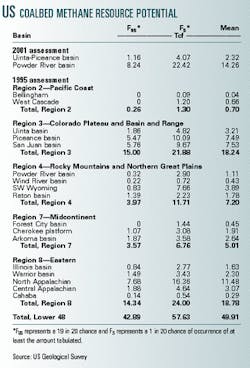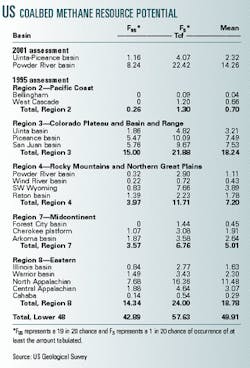The US Geological Survey has slashed estimates of Uinta-Piceance basin coalbed methane resources, but substantially raised them for the Powder River basin.
Gene Whitney, a supervisory geologist, testified at a recent House Energy and Mineral Resources Subcommittee oversight hearing on CBM issues.
Meanwhile, a CBM producer complained at the hearing that permitting delays and other regulatory barriers are slowing development of this burgeoning resource.
Testimony
Whitney said USGS estimates the Uinta-Piceance basin of Colorado and Utah holds, at the mean, 2.32 tcf of undiscovered, technically recoverable CBM, down sharply from the 1995 estimate of 10.7 tcf.
But the estimate for the Powder River basin of Wyoming and Montana is 14.26 tcf, up from 1.11 tcf in 1995.
Whitney said CBM accounts for 8% of US gas reserves and 7% of gas production.
He said that, historically, the San Juan basin has been the most productive CBM basin, with two thirds of the known reserves and 80% of the production. Second is the Warrior basin in Alabama with 8% of reserves and 9% of output.
"This picture is changing, however, with the emergence of other western US coalbed methane basins." In particular, he said, the Powder River basin in Wyoming is experiencing a boom because the coal beds are thick-up to 300 ft-but are at shallow depths, making wells inexpensive to drill and operate.
"Exploration and production activity in the Powder River basin began to increase geometrically once coalbed methane developers understood the production techniques necessary to successfully produce the gas."
Whitney said 110 CBM wells in the basin produced 6.5 MMcfd of gas and 949,637 gal/day of water in May 1994. He said that, 7 years later, 5,446 wells were producing 642 MMcfd and 61.1 million gal/day.
He said produced water is a problem in CBM areas because it often is of low quality and must be reinjected, affecting the economics of the wells.
Also, the US Environmental Protection Agency has reported citizen complaints of "groundwater well contamination they believe is due to hydraulic fracturing resulting from coalbed methane production." He said EPA is studying the issue (OGJ, Sept. 10, 2001, p. 40).
Industry view
Don Wallette Jr., Phillips Petroleum Co.'s Rocky Mountain regional manager, said CBM production faces major problems.
Phillips produces CBM from 1,660 wells in the US and has nearly $500 million invested in CBM activities in the West.
"We are gravely concerned and significantly impacted by continuing delays in completion of the Powder River basin CBM environmental impact statement. The development of the coalbed methane in the Powder River ba sin has been hampered by a drilling moratorium since early 2000 and will continue to be delayed until such time as the EIS is completed."
Wallette said the US Bureau of Land Man agement has assessed how much gas is being drained from federal lands by nonfederal wells and has authorized up to 2,500 wells in the basin.
About a third of those drainage permits have been issued, and the rest are expected by yearend.
"Meanwhile, we wait for the results of the EIS, which will determine whether and how industry will proceed with the 50,000 CBM wells required to fully tap the gas resource."
He said BLM was due to issue the draft EIS by July 1 but has not. A final decision on the EIS is not expected until late next summer.
Wallette also said the growth of gas activity in the West, particularly with respect to CBM, has far outpaced BLM's ability to respond in a timely manner.
He said BLM has predicted that applications for permits to drill will increase 58% in 2002 and that reservoir drainage cases will increase similarly. "Meanwhile, staffing-which should be activity related-is expected to increase 4.7% from 2000 to 2002."
Wallette said prices are another impediment to CBM development. "Natural gas produced in the Powder River basin commands the lowest price of any gas in the nation, with discounts to [New York Mercantile Exchange futures prices] approaching $1/MMbtu.
The reason for this is not because the quality of the gas is inferior, but because there are significant bottlenecks in the transportation system, creating gas-on-gas competition.
"In Utah, our gas production has been curtailed significantly while we wait on needed expansions to be completed in the transportation system. It will do little good to resolve the issues associated with development of CBM unless the impediments associated with marketability are simultaneously ad dressed."

